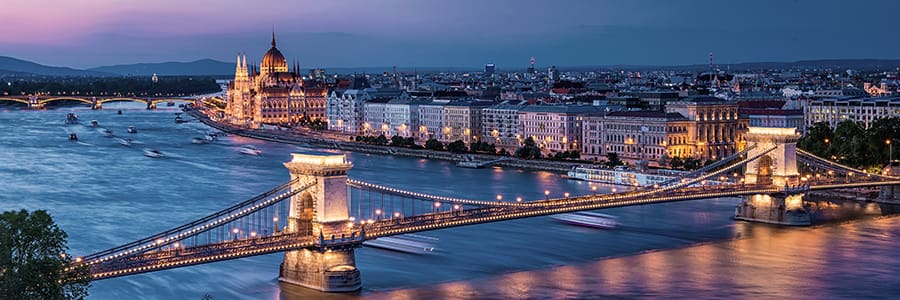
About The Danube River
The Danube was known to the ancient Greeks as the Istros, meaning “strong, swift.”
Its second-longest river, the Danube is the heart of central Europe, home to some of the earliest human cultures and long the northern frontier of the Roman Empire. Originating in Germany’s Black Forest, it flows southeast for 1,780 miles, passing through or along the borders of Austria, Slovakia, Hungary, Croatia, Serbia, Romania, Moldova, and Ukraine, before emptying into the Back Sea.
Boasting countless natural and cultural attractions, including dozens of UNESCO World Heritage sites, the Danube region attracts millions of visitors a year, with more than 70 cruise lines operating each season. From hilltop castles and wonderfully-preserved medieval villages like Regensburg to lush vineyards and imperial capitals like Vienna and Budapest, the “waltzing blue Danube” delivers a feast for the senses along every unforgettable mile.
Residents of this historic river have been perfecting the art of hospitality for centuries, and few experiences capture the romance and luxury of the Danube like a river cruise. From your “floating hotel,” each day brings another breathtaking vista, with new treasures to be explored and new memories to be made, all as easily as strolling into town … or waltzing on deck of your river cruise ship under the stars at night.
Danube River Stats
Length: 1,727 miles
Depth: 3 to 26 feet
Source: Black Forest of Germany
Mouth: The Danube Delta into the Black Sea, Romania
Locks: 19
Countries: Germany | Austria | Slovakia | Hungary | Croatia | Serbia | Bulgaria | Romania | Moldova | Ukraine
More about the Danube River
The Danube River, known as the “Queen of Europe’s Rivers,” is a majestic waterway that flows through the heart of Europe. Stretching over 2,850 kilometers (1,770 miles), it is the second-longest river in Europe after the Volga. This iconic river has played a pivotal role in shaping the history, culture, and environment of the continent for millennia. In this exploration, we will delve into the rich tapestry of the Danube, from its source in Germany to its delta in Romania and Ukraine, covering its historical significance, ecological importance, and its role in modern Europe.
The Danube’s Origins
The Danube’s journey begins in the Black Forest of Germany, near the town of Donaueschingen. Here, two small tributaries, the Brigach and Breg rivers, converge to form the Danube. From this humble origin, it embarks on a remarkable journey, flowing through ten European countries: Germany, Austria, Slovakia, Hungary, Croatia, Serbia, Bulgaria, Romania, Moldova, and Ukraine.
Historical Significance
The Danube has witnessed the rise and fall of countless civilizations and empires. Its strategic location made it a natural trade route for the Romans, who referred to it as the “Danubius.” The river connected the Mediterranean to the Black Sea and played a pivotal role in the Roman Empire’s economic and military power. Numerous fortifications, bridges, and settlements sprang up along its banks during this time. During the Middle Ages, the Danube continued to be a vital trade route. The great city of Vienna, for instance, prospered as a Danube trading hub. Castles and fortifications were built along the riverbanks to protect merchants and travelers. In more recent history, the Danube became a political and cultural dividing line during the Cold War, separating the Eastern and Western blocs of Europe. The Iron Curtain ran along parts of the river’s course, symbolizing the ideological divide between East and West.
Ecological Importance
Beyond its historical significance, the Danube is a lifeline for the diverse ecosystems it traverses. Its basin spans over 800,000 square kilometers and is home to an array of flora and fauna. The river and its floodplains support countless species, including sturgeon, otters, beavers, and various migratory birds. The Danube River Basin also provides water for agriculture, industry, and domestic use to millions of people in the countries it flows through. This reliance on its waters has necessitated careful management and conservation efforts to protect its ecological balance.
Challenges and Conservation
The Danube has faced numerous challenges in recent decades. Pollution, industrial runoff, and agricultural runoff have threatened water quality and aquatic life. Efforts have been made to reduce pollution, including international agreements like the Danube River Protection Convention. Wetland restoration projects and the establishment of protected areas have also contributed to the river’s conservation. Additionally, the construction of hydroelectric dams along the Danube has generated both benefits and controversy. These dams provide renewable energy but disrupt the natural flow of the river, impacting fish populations and the river’s ecosystem.
The Danube Today
Today, the Danube serves as a vital artery for transportation and trade in Europe. Numerous cities along its banks, including Vienna, Budapest, and Belgrade, depend on the river for commerce and tourism. River cruises are a popular way for tourists to explore the diverse landscapes and cultures of the Danube basin. The European Union has recognized the importance of the Danube as a unifying element in the continent’s history and a key player in its future. The European Strategy for the Danube Region (EUSDR) aims to promote cooperation and sustainable development in the region.
